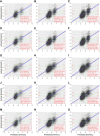Early detection of type 2 diabetes mellitus using machine learning-based prediction models
- PMID: 32686721
- PMCID: PMC7371679
- DOI: 10.1038/s41598-020-68771-z
Early detection of type 2 diabetes mellitus using machine learning-based prediction models
Abstract
Most screening tests for T2DM in use today were developed using multivariate regression methods that are often further simplified to allow transformation into a scoring formula. The increasing volume of electronically collected data opened the opportunity to develop more complex, accurate prediction models that can be continuously updated using machine learning approaches. This study compares machine learning-based prediction models (i.e. Glmnet, RF, XGBoost, LightGBM) to commonly used regression models for prediction of undiagnosed T2DM. The performance in prediction of fasting plasma glucose level was measured using 100 bootstrap iterations in different subsets of data simulating new incoming data in 6-month batches. With 6 months of data available, simple regression model performed with the lowest average RMSE of 0.838, followed by RF (0.842), LightGBM (0.846), Glmnet (0.859) and XGBoost (0.881). When more data were added, Glmnet improved with the highest rate (+ 3.4%). The highest level of variable selection stability over time was observed with LightGBM models. Our results show no clinically relevant improvement when more sophisticated prediction models were used. Since higher stability of selected variables over time contributes to simpler interpretation of the models, interpretability and model calibration should also be considered in development of clinical prediction models.
Conflict of interest statement
The authors declare no competing interests.
Figures



References
-
- International Diabetes Federation. IDF DIABETES ATLAS (2017), 8 edn.
-
- Rahimloo P, Jafarian A. Prediction of diabetes by using artificial neural network, logistic regression statistical model and combination of them. Bull. Soc. R. Sci. Liège. 2016;85:1148–1164.
-
- Wu H, Yang S, Huang Z, He J, Wang X. Type 2 diabetes mellitus prediction model based on data mining. Inform. Med. Unlocked. 2018;10:100–107. doi: 10.1016/j.imu.2017.12.006. - DOI
Publication types
MeSH terms
Substances
LinkOut - more resources
Full Text Sources
Medical

